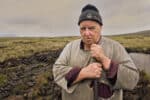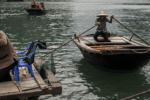
Humankind has an eternal fascination for the sun. Understandable. The center of the universe, the flame in the sky around which all life rotates. We worship it, raising our hands and faces upwards to seek its warmth. We despair without it. Absent the sun, darkness of life and spirit occurs. We bask and bake in it, flocking to beaches, drenched in oil, veritably roasting in its rays. We need it for things to grow and sustain life, and have consequently tried in various ways to harness its astonishing power. This has produced mixed results. On the positive side of the ledger–solar power! As a for instance. On the flip side, can anyone forget Doc Ock? “The power of the sun in the palm of my hand!” Okay, hold the phone on that one.

The holy grail of channeling the sun’s power has always been nuclear fusion. In nakedly simple terms, the goal is to produce endless clean, sustainable power by creating a series of nuclear fusion reactions inside of formidably complex establishments known, logically, as nuclear fusion reactors. The game is to blast the bejesus out of lighter atomic nuclei so hard, with so much power, that they fuse into a heavier nucleus, and release energy. This, scientifically speaking, is not a walk in the park. The physics, the engineering, the exactitude brought to bear on this hyper complex frontier in nuclear fusion is next level.
NIF just did it. The National Ignition Facility, located at Lawrence Livermore Labs in California, just achieved a result where the return of energy (output) was greater than the energy input. There is still a long way to go, but this is unbelievably significant news, certainly more important than say, where a reality TV star is vacationing for the holidays.
Below, scientists are portrayed with a mix of the myriad tools in this giant assemblage of moving parts. Elizabeth Dzinitis with timing targets (many of which get vaporized in the shots), and in the closeup, Patrick Crowley first minutely examines a target and then, applies adhesive with…an eyebrow hair.



I was fortunate enough to visit NIF twice, some years ago, while it was under the guidance of the visionary Ed Moses, a physicist who understands the value of a photograph, and the fact that scientists can’t simply work endlessly behind the curtain, issuing the occasional arcane white paper about joules and gain factors and expect the public to remain interested in nuclear fusion. Science is fascinating. Science is cool. Science is bloody tough to photograph.

I mentioned the power to blast atoms is not easily achievable. NIF did it with lasers (there are other types of fusion reactors). But NIF is laser based. 192 of them. Stretching out in laser bays that are, I don’t know exactly, but you could probably play a football game inside the building. When the team goes for “a shot” these lasers are brought to bear on a target about the size of a pencil eraser, which is suspended in the middle of a target chamber about ten meters wide. Explosions occur. 500 trillion watts of power, delivered in about 20 billionths of a second. I mean, I love The Rock, but Black Adam, step aside. (Though enjoyed the movie!)

The target chamber, seen below, is designed to defeat light, and is blackened by all the blasting from test shots. It used to look pristine and gleaming, such as below, which was the first time I got a glimpse of it. So shiny was this giant, metallic golf ball that I only used one flash. Bare tube. Ricocheted all over the place.

But no longer. The nuclear blasts inside the chamber have not only darkened it, but have it dripping in radiation. This was where I had to go. Ascending on a lifter, Dave Bower, the gentleman who went in with me said, as we were ascending, “Joe, not too many people get a chance to do this!” An amazing and enthusiastic guide. Helped me out endlessly inside there, as I had to work my cameras through heavy plastic, gloves, a hazmat type suit, forced air, and a shielded visor. And then try my best to focus the damn camera. But I had to chuckle. In my head I was like, “Yeah, going into a radiation field! I love my job!”
Ascending into the target chamber below.

Arriving at the target with John Bower. Given the encumbrances of the heavy plastic swaddling my cameras, I really went old school on the lighting, by the way. Dropped two heavy duty strobes down through the portals into the chamber, themselves heavily wrapped in plastic. Also dropped sensor eyes. Triggered the whole damn thing with a single Nikon Speedlight.

Another view of the chamber. And, as you can see, it’s no longer shiny and new. It’s weathered the impact of hundreds of test explosions.

For this view, I had to be harnessed and slid down one of the access portals that populate the target chamber.

This was where some of the fun started. I was shooting a 16mm fisheye, and had to stretch my arms out full extension to try to get that super-wide lens past the portals where my lights had been dropped into. In doing so, my protective suit separated at the wrist and my skin brushed the interior of the chamber. This was observed of course, and immediately when I came out, that area of my arm had to be swabbed down and, as I remember, skin samples taken. I had to have urine tests for the next three days, etc. About a month or so downstream I received notification that I had received no significant exposure to radiation.

Definitely one of the most unusual and stirring assignments I ever had. A window onto complexity beyond my imagining. Scientists grappling with the primordial power of the sun. Not for the faint of heart. To have faith in this process, ongoing as it is, to borrow from Matt Damon in the film, The Martian, they have to “science the shit out of this.”
Hence it was a privilege to be there, especially with my extraordinarily talented crew. Drew Gurian, Michael Cali, and Mike Grippi.

And me, I just kind of continue to glow in the dark. 😉

Wonderful story. Wonderful opportunity to shoot hardcore science at work, something I have always loved to do, and continue to welcome. In some ways, emblematic of the life and career of a photog. By virtue of carrying a camera, we often are allowed to see that which many cannot. We have an extraordinary window into so many different realms of the human experience. A blessing of this endeavor.
And another emblem of a photog’s life? Nat Geo killed the story. Never published a frame. That’s ok. I have the photos! And still standing, shooting jobs, camera in hand.
More tk….














Great photos and storytelling, as usual! Brings back memories! Nat Geo really missed the boat on that article!. There was a predecessor fusion research system BFA-II (Particle Beam Fusion Accelerator) at Sandia. National Labs in the mid-90’s. Much smaller – They only used 36 pulse generators instead of 192 mid-90’s). The whole containment system was much smaller as well.
Have a very Merry Christmas!
Great to hear from you, Larry! Hope all is well. NIF is an amazing place.
Amazing work. I had the privilege of learning from you at two military photography workshops. I’d like to share this with my High-school students after the break.
Nat Geo cancelled the story! I wonder what they are saying now? Great story. And fantastic images.
Thanks for sharing your vision on this extraordinary science lab! Thanks to your amazing work in the file the public now can have an idea of how complex and how amazing this achievement represents for human kind! Keep sharing you amazing work that inspires all of us! Happy Holidays!
Sounds great, John…..enjoy the holidays!
I had read about the NIF’s recent milestone. But, interesting as the topic was, it did not come to life the way that you just made it do. It’s such a pleasure to read your exploits and enjoy your images. THANKS!!!
Hi Carlos! Many thanks for stopping by the blog. Appreciate it. Hoping you and your family have great holidays. All the Best, Joe
Once again McNally nails the shot ! I never miss an opportunity to read of the exploits and the realms that you go to ‘get the shot’ and the inspired work you deliver Joe.
Excellent story. Can’t believe National Geographic didn’t publish it.
That’s fascinating text and the pictures are great. Thank you!
Hi Joe,
What an amazing place for a photoshoot. I’m really happy that they let you do your thing – it must have been an absolute joy for you
I love this page S2